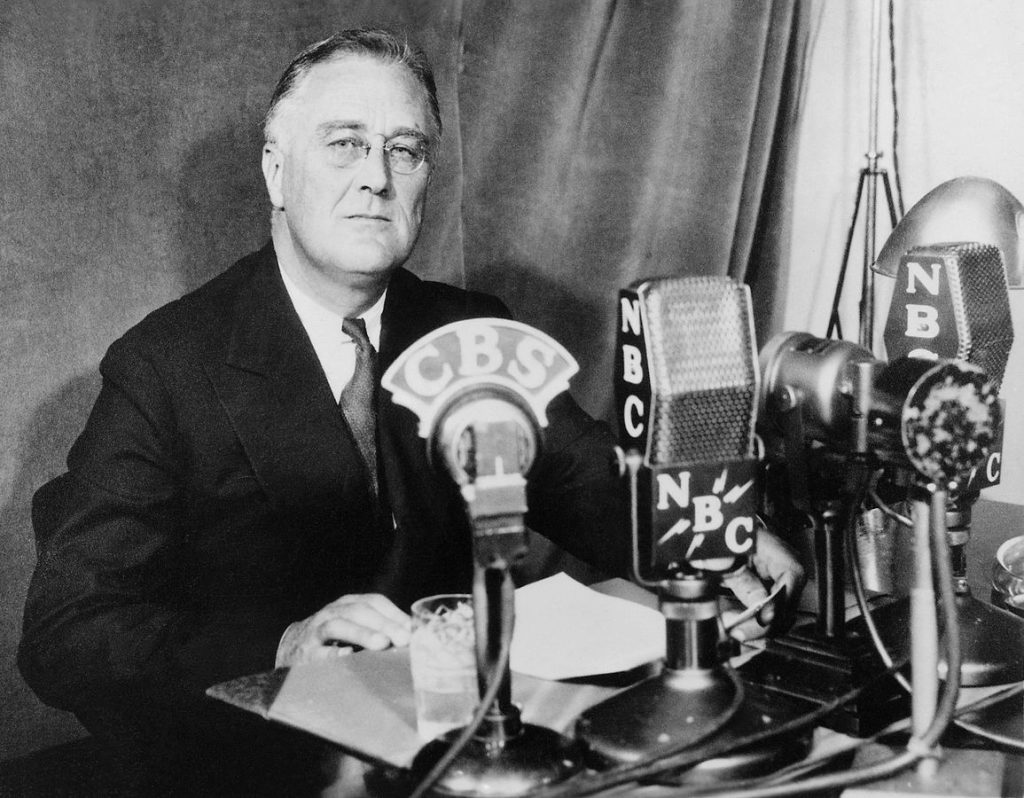BOOSH…In an instant the United States naval base, Pearl Harbor, was attacked by Japanese military planes; hundreds of U.S. military personnel, as well as U.S. civilians, were killed. The country was shaken to its core, even President Franklin D. Roosevelt. President Roosevelt wasted no time on that afternoon and evening of December 7, 1941. Within mere hours, President Roosevelt established a War Council meeting to address his most trusted officials, informing them that entering the war had now become a reality. After that War Council meeting, President Roosevelt was in dire need of rest, to recover from the news of the bombing, so much so that President Roosevelt required his otolaryngologist to treat his inflamed and swollen nasal passages. Even though the attack was clearly taking its toll on FDR, he only rested for a short period of time before calling three more meetings, which lasted through the night and into the morning of December 8, 1941.1
After the meetings with the President’s staff in the morning of December 8, Roosevelt addressed Congress in one of the most historical speeches in American history, declaring that the day that Japanese attacked Pearl Harbor would be a “date which will live in infamy.”2 Then, President Roosevelt leveraged the infamous attack to justify a declaration of war on Japan to avenge the fallen. In response to Roosevelt’s overwhelming passion, as well as the country’s anger and vulnerability, the majority of Congress passed the declaration of war on Japan. With the passing of the declaration of war, it was made clear that the request for war was limited to Japan because their military had acted alone in the bombing. Roosevelt, however, really wanted to go to war with not only Japan, but also with Germany and its ally Italy. So, in order to rage war on Hitler and all of his allies, Roosevelt had to put pressure on Hitler using one of his official radio addresses to the public. These official radio addresses were known as “Fireside Chats,” which Roosevelt had begun at the beginning of his presidency in 1933. In these radio “chats,” President Roosevelt provided comforting and informative words to the American public so that they could have some reassurance. Two days after the attack on Pearl Harbor, Roosevelt gave his highly anticipated “Fireside Chat,” where he stated that “Germany and Italy, regardless of any formal declaration of war, consider themselves at war with the United States at this moment, just as much as they considered themselves at war with Britain or Russia.”3 Such a statement immensely added to Hitler’s reasons for finally declaring war on the U.S. on December 11, 1941.

Prior to the bombing of Pearl Harbor, almost all of President Roosevelt’s “Fireside Chats” were about how the U.S. needed to stay out of the war. So, one might think that American citizens would be angered at President Roosevelt’s flip to engaging in the war. But in fact, a large majority of American citizens stood behind Roosevelt in engaging in the war. Thus, when the United States officially entered the war, everyone, even the people who claimed to support isolationism, found some relief in the fact that the country was taking steps to avenge their people. Though, all reliefs could not be quelled with the action of war, due to the simple fact that a majority of U.S. citizens still felt high levels of vulnerability because of their “enemy,” the Japanese-Americans, being their next-door neighbors. Now, Japanese-Americans had long been a disliked and unwelcomed people long before the Japanese attack on Pearl Harbor. Their coming to America and taking jobs from the already existing U.S. citizens had long stirred zenophobic anxieties. 4 So now with a Japanese attack having taken place on U.S. soil, those anxieties rose even higher against the Japanese-Americans. Many of these Japanese-Americans were intuitive enough to realize that resentment was coming, and went to great lengths to either reassure their fellow U.S. citizens or hide from them. For example, Saburo Kido, the president of the Japanese American Citizens League (JACL), took the initiative to send a telegram to President Roosevelt informing him that “Japanese-Americans are stunned and horrified at…[the] unwarranted attack by Japan upon American soil, our country. We want to convey to you that we unequivocally condemn Japan for this unprecedented breach of good faith.”5 Kido even pledged that the JACL would do everything possible to assist in “the defense of [their] land against this attack [and relinquish their] fullest cooperation” to President Roosevelt and the United States. Although Kido and the JACL relayed some reassurance to President Roosevelt, they were not successful in squashing the rumors about Japanese spies in America. Somehow newspapers got a hold of “evidence” proving that Japanese spies were to blame for Pearl Harbor, and many citizens believed them without a doubt, because they wanted so badly to see the Japanese-Americans as the enemy. Such negative sentiment was fueled by newspapers that ran headlines like “Slap the Jap Rat,” and consequently drove Japanese-Americans into hiding by claiming that they were of another Asian ancestry, so that they could avoid as much hatred as possible.
Quickly, hiding became ineffective for Japanese-Americans, because citizens who were not Japanese began to apply pressure on the government to ensure their safety by placing regulations on Japanese-Americans. The first step in these regulations was a 9:00 P.M. curfew for “enemy aliens,” which was a legal way of saying Japanese-Americans. It was enacted on February 4, 1942. This major regulation on Japanese-Americans, however, was not satisfying enough to West Coast citizens and political officials who felt more vulnerable due to their close proximity to Japan and their higher Japanese-American populations. So, where do they go from here? They went to President Roosevelt to demand that he take action to protect the majority of U.S. citizens by pushing the Japanese-Americans two-hundred miles inland, for the “safety” of all.6 For awhile, President Roosevelt chose to evade the pressures of the West Coast, and he even avoided his advisers, because he recognized that the status of Japanese-Americans was a sensitive situation; he had to balance safety and rights. Did the safety of one group of citizens require that another group of citizens had to sacrifice their rights? Unfortunately, as war tensions escalated so did the ideas for regulating Japanese-Americans. In fact, the ideas even called for their relocation. This idea of relocation suggested that Japanese-Americans had to be moved inland and be monitored by military authorities. Again, President Roosevelt realized the injustice in the action of relocating all Japanese-Americans, but he became overwhelmed by plea after plea from U.S. citizens and government advisers about how the relocation was a “military necessity” that would protect the country from “Japanese spies.”7 So, like any human being, President Roosevelt gave into the pressures of war, and chose to sacrifice Japanese-American rights by signing Executive Order 9066 on February 19, 1942.

In short, Executive Order 9066 authorized the “War Department to designate certain land as military areas and handing it the right to evacuate from those areas anyone it deemed a threat,” though the order would go on to only be enforced against Japanese-Americans on the West Coast.8 Furthermore, February 19 was only the dreadful day that President Roosevelt signed Executive Order 9066. It wasn’t until March 9, 1942, when the order began to shatter thousands of loyal Japanese-American lives.9 The evacuation began with “Civilian Exclusion Orders” posted in all areas with Americans of Japanese ancestry, detailing what to do as far as belongings and where to go. Ultimately, the Japanese-Americans cooperated because they felt it was the simplest way to reassure the country that they were no threat. Though, just because they cooperated didn’t mean that the U.S. military went easy on them. In fact, one of the harsh requirements on all Japanese-Americans was for them to sell their property because it was deemed that they would no longer need their property. From here, the Japanese-Americans would live in military internment camps that were located in unirrigated deserts that left them to suffer in scorching heat or icy cold weather. Ideally, these camps were built to allow the internees to go about their lives working and learning, but just in a military and barbed wire area. Now, there were no gas chambers or crematories, but internees were still abused and occasionally killed under mysterious circumstances. So, no, these camps were nothing like the German Death Camps, or even German concentration camps that existed at this same time; but they were nonetheless a nightmare for Japanese-Americans, and a complete violation of their rights as citizens of the United States. 10

As the war was drawing to a close, and progressing in the United State’s favor, President Roosevelt recognized that there was no longer any justification for holding Japanese-Americans behind barbed wire. So, in December of 1944, President Roosevelt rescinded Executive Order 9066 and announced that all Japanese-Americans could return home on January 2, 1945. After Roosevelt’s announcement, all camps were officially closed in early 1946, because the government wanted to ensure all of the internee’s loyalty to the United States.11 Now, just because President Roosevelt announced that all Japanese-Americans were freed doesn’t mean that they were immediately loved. In fact, they were discriminated against even more. Part of this discrimination was due to the strong emotions aroused by the war. People felt that they were still justified in their discrimination of Japanese-Americans because of the creation of the internment camps. President Roosevelt might have been able to sooth the people faster with a Fireside Chat or by encouraging the reintegration of Japanese-Americans, but he died from a stroke on April 12, 1945. So, with the loss of President Roosevelt, the Japanese-Americans were left to fend for themselves to regain trust from their fellow countrymen. Consequently, the Japanese-Americans would have to wait forty-three years for resentment to reach a level where they would receive an official apology from their government, and twenty-thousand-dollar compensation for the life-scarring internment. But no amount of money or apologies can ever undo the horrific actions the United States government conducted in one of its darkest hour.12
- Paul Burtness and Warren Ober, “Provocation and Angst: FDR, Japan, Pearl Harbor, and the Entry into War in the Pacific,” Hawaiian Journal of History 51, (2017): 108-110. ↵
- Greg Robinson, By Order of The President: FDR and the Internment of Japanese Americans (Cambridge, Mass: Harvard University Press, 2001), 74. ↵
- Paul Burtness and Warren Ober, “Provocation and Angst: FDR, Japan, Pearl Harbor, and the Entry into War in the Pacific,” Hawaiian Journal of History 51, (2017): 110. ↵
- John F. Wukovits, Internment of Japanese Americans (Detroit: Lucent Books, 2013), 15-17. ↵
- John F. Wukovits, Internment of Japanese Americans (Detroit: Lucent Books, 2013), 21. ↵
- John F. Wukovits, Internment of Japanese Americans (Detroit: Lucent Books, 2013), 20-29. ↵
- John F. Wukovits, Internment of Japanese-Americans (Detroit: Lucent Books, 2013), 30-32. ↵
- John F. Wukovits, Internment of Japanese-Americans (Detroit: Lucent Books, 2013), 32. ↵
- “Executive Order 9066 passed in the US,” History Today 67, no. 2 (2017): 9. ↵
- John F. Wukovits, Internment of Japanese-Americans (Detroit: Lucent Books, 2013), 34-40. ↵
- John F. Wukovits, Internment of Japanese Americans (Detroit: Lucent Books, 2013), 96-97. ↵
- Joyce Moss and George Wilson, Literature and Its Times: Profiles of 300 Notable Literacy Works and the Historical Events that Influenced Them (Detroit: Gale, 1997), 137-143, http://link.galegroup.com/apps/doc/CX2875100248/GVRL?u=txshracd2556&sid=GVRL&xid=489a8828. ↵



76 comments
Michael Leary
Very interesting article, I had read about this issue in high school. It is important to know that it is very easy to be critical of the past actions of the US government, but, is important to analyze the situation from many points of view in order to understand why it happened. It is a sad thing that citizens and residents were moved and treated as prisoners of war due to their ancestry, but, is important to remember that there was a legitimate threat of espionage and sabotage that could occur. It is also important to remember that there were thoughts of a Japanese invasion on the West coast and many people did not want to find out if anyone would join their ancestral country.
Sharriah Martinez
I remember reading and learning about pearl harbor in high school. I became very interested and actually watched the long pearl harbor movie. Although yes it was structured as a love story I learned alot about the tragic event. This article did a good job at explaining the internment camps for Japanese Americans. fear can lead a country to do alot of things
Nawaf Almarwaie
after Pearl Harbor had been attacked by the Japanese military planes, United States found itself in a position where they have to decide whether to enter the war or not, as a result U.S had to enter the war for many reasons, such as, its security, and its reputation. nevertheless, that did not prevent U.S from entering the world war 2, especially after German an Italy declaration of war against United State, which affect the whole worlds economy, healthcare, and other problems such as, poverty. not only that, but also changed the future of the whole world.
Joshua Garza
America throughout its history has had many faults that they acknowledged but choose to not go back and learn from them as an entire population. This however is one wrong that we did that is often forgotten about. With our prejudiced history we only choose to see the bad we have done when its the only thing too see but take a situation like this when we as a nation honorably triumphed as a country to defeat or enemy overshadows the inhumane acts done while these things were simultaneously going on.
Dalton Moy
I am very glad I chose to read this article. I do remember learning about the internment camps in high school, however not much detail was presented to us, except the point that they were vaguely similar to the concentration camps in Europe. The topic of Japanese-American internment camps is not a topic that is very comfortable to think about, however it is important to do so. It is important to see what fear can lead to in a country, and this article does an amazing job of describing this historical example.
Samantha Luckey
Congratulations on being nominated for your article! Before reading this article, I already knew details about this subject, but this article provided new information and was very informative, especially the video at the end. Overall the writing was well done, and this author was able to engage the reader to continue reading on, as well as, informing the reader of important details over the effects of World War II. Great work!
Max Lerma
Congratulations on your nomination for an award at the upcoming ceremony! I believe that your article gave a great historical background to this issue and the detailed description you gave of the camp really showed the conditions the detainees lived in. I had heard of this issue before. My grandfather would tell me about how he used to live in Crystal City, Texas during the war and he would see the Japanese people in the camp that had been set up just outside the city limits. It is hard to fathom that the U.S. was capable of this and was capable of it not that long ago. We have not come very far either as we detained migrant children. We must stop this travesty and remember our history no matter how dark it may have been.
Robert Rees
It’s horrible to think that while America was fighting against Germany, who was placing millions of people in concentration camps, that we were placing our own innocent citizens into similar camps. Even after these same citizens expressed the same shock and outrage over the attack on Pearl Harbor, and that Saburo Kido reached out to the President to reassure him that Japanese stood with the U.S., we still allowed our anger and grief to cloud our minds in a manner that is by no means excusable. The discrimination towards Japanese Americans during WWII was unacceptable and should serve as learning example for why it is important to always safeguard human rights, as well as not letting emotions dictate our actions during times of war. This is fantastic article, more than deserving of its nomination. Congratulations.
Irene Astran
I wonder what this historic event would have looked like if time was taken to think through the decision to reign down on Japanese forces and civilians. The prejudice and discrimination that came from it will live on in history as one of the most egregious acts by Americans over other Americans. The forceful movement of Japanese Americans into internment camps was truly horrific.
Adam Portillo
I really enjoyed reading this article. It’s awesome to see that the article was very informative on this controversial topic. There’s both pros and cons for relocating the Japanese Americans, but ultimately I feel that it was a bit over the top to go to those drastic measures. The treatment they received was harsh and way too excessive. Overall, this was a very well written informative article. Good job.